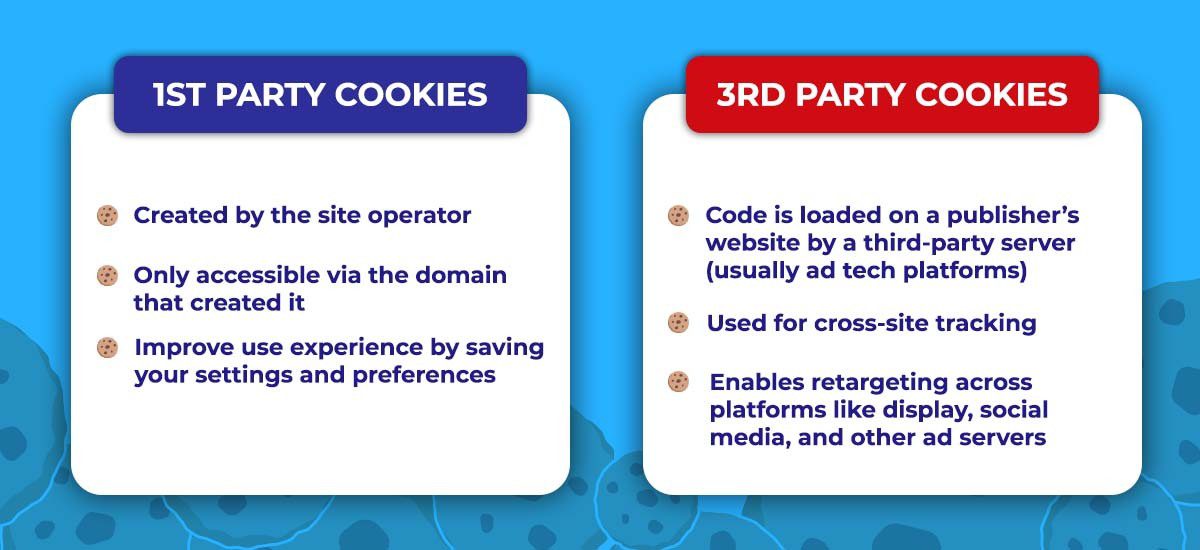It’s official: third-party cookies are crumbling. It’s time to start planning for a cookieless future.
Digital marketing is a fast-moving, ever-changing industry. We live in an age where technology is improving at an exponential rate. Businesses have more access to consumer data than ever before, which leads to more targeted ads and highly effective campaigns.
It’s hard to get through a single day without an ad coming across your browser, email, or social media feed that feels directed at you.
In fact, you’ve probably experienced this scenario: an ad pops up for something you googled a few days ago. Suddenly you’re thinking about that product again.

Targeting makes viewing ads less painful and more beneficial for the consumer. Instead of being bombarded with advertisements hoping to get lucky and score a conversion, consumers see ads featuring products they are interested in purchasing.
But how exactly does this work? How does one website know the exact pair of shoes you were looking at on a different website two days before?
The answer is through the use of third-party cookies, which will be going away entirely as early as 2022.
Most everyone knows of cookies, but if you aren’t familiar, you have at least seen the pop-up that asks whether or not you will accept them. But what exactly are they, and how do they impact your privacy?
What are Cookies? The Difference Between First-Party and Third-Party Cookies


A cookie is a small block of data that tracks a user’s actions on a website, including but not limited to:
- which parts of the page they visit
- items they have in the shopping cart
- how long they are on the site
First-party cookies are cookies that are stored only by the website you are visiting.
These cookies help make the user experience better by remembering passwords, items in the shopping cart, or recommending products to a returning customer.
Without first-party cookies, our internet experience would be much less convenient.


Third-party cookies (or 3p cookies) track user actions like first-party cookies do, but the data is not for those who run the website. It is utilized for online advertising purposes more than user experience purposes. A third-party cookie will track your actions across multiple websites and deliver targeted ads based on your behavior.
It’s third-party cookies that see the pair of shoes sitting in your Amazon shopping cart and delivers an ad for those same shoes to you on a completely different website.


What is Happening to Third-Party Cookies?
As technology continues to advance, consumers are becoming more informed and up to speed on the tactics around digital marketing. The digital age has also caused consumers to become more concerned with online privacy and handling their data.
Even though 3p cookies make advertisements more relevant and purposeful, many consumers don’t like that their personal information is collected.
And lawmakers are listening.
The EU’s General Data Protection Regulation (GDPR) and the California Consumer Privacy Act (CCPA) are just two regulations already in place to preserve consumer privacy.


Navigating cookieless advertising will be one of the most daunting challenges for digital marketers. Firefox and Safari have already eliminated third-party cookies, and Google Chrome plans to do so by 2022.
How Will This Impact Consumers?
A cookieless future means tracking and targeting will be significantly diminished. Consumers will notice fewer personalized ads, which may create a sense of increased transparency between them and companies.
Although companies will continue to target consumers through numerous advertising strategies, their data will not be used or sold for other purposes.
How Will This Impact Marketers?
The challenge that marketers now face is a big one: consumers expect personalization yet demand privacy.


It will be no straightforward task for marketers to navigate this unfamiliar landscape. Still, it will be necessary and worth it as the times change. The end of 3p cookies doesn’t mean personalization is over; it merely means that priorities and strategies need to change.
The best thing marketers can do is start preparing now by prioritizing and strengthening first-party data while relying less on 3p cookies.
Google wants to be sure they are prepared for this new landscape. They are slowly phasing out third-party cookies now to ensure that, in future, their new solution will work for advertisers and preserve the digital advertising industry in a post-cookie world.
How Should Marketers Prepare For a Cookieless Future?
Marketers must adjust their strategies and go back to fundamental principles. Fundamental advertising tactics will remain critical as the digital landscape changes.


Since consumer data can no longer be exclusively relied on to achieve digital marketing goals, we recommend the following strategy to prep for a post-cookie world:
Prioritize first-party data. Advertising with first-party data will be crucial in the cookieless future.
First, figure out which first-party data you already have and are currently collecting and determine how to gather more.
Next, dive into your website’s analytics to figure out the behavior of your users. You can also:
- Conduct A/B tests on Google Ads and Facebook to test different advertisements and audiences.
- Offer promotional surveys to gather information about your customers.
- Use lead gen forms on social media to collect emails and other demographic data.
- Offer valuable content to your customers if they answer a couple of questions.


Go back to the basics. These tried-and-true tips aren’t groundbreaking but will help you stay consistent in a post-cookie world:
- Develop eye-catching visuals and compelling messaging.
- Offer content to your customers that they actually want.
- Continuously critique and improve your brand.
- Make sure your website is easy to navigate and aesthetically pleasing.
- Consistently post on social media and interact with your customers.
Adapting has always been essential in the ecosystem of marketing. From placing ads in newspapers to telemarketing to personalized messages on your phone, marketers have consistently had to stay aware and adapt to the times. Remember, no digital marketing tactic lasts forever.
As the game changes, the players must adjust. The cookieless future is approaching fast, and digital advertisers must adapt now or be left in the dust.
Talk to us today about how our team of developers and media strategists can help you navigate a cookieless world!


